Home / Albums / Tag Place:America 873

 Ed Wynn
Ed Wynn Charlie Chaplin
Charlie Chaplin Douglas Fairbanks
Douglas Fairbanks Carl Van Vechten
Carl Van Vechten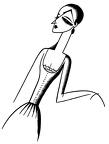 Carlotta Monterey
Carlotta Monterey Babe Ruth
Babe Ruth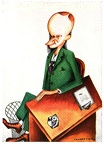 Calvin Coolidge
Calvin Coolidge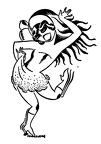 Ann Pennington
Ann Pennington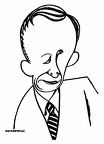 Avery Hopwood
Avery Hopwood Alexander Woollcott
Alexander Woollcott Al Smith
Al Smith We’ll Enter to Win, Boys!
We’ll Enter to Win, Boys! It’s P. E.!
It’s P. E.! It was a Massive Silver Cup
It was a Massive Silver Cup 'We are Going to Win,' Declared Harriet
'We are Going to Win,' Declared Harriet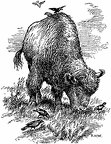 Buffalo grazing
Buffalo grazing Hidatsas burial scaffolds
Hidatsas burial scaffolds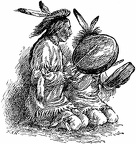 Drums on a summer's evening
Drums on a summer's evening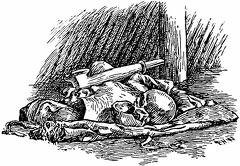 Grandfather sacred medicines
Grandfather sacred medicines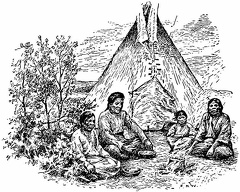 At this hour, fires burned before most of the tepees
At this hour, fires burned before most of the tepees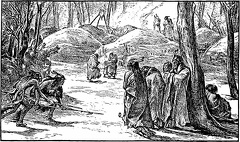 Winter Camp
Winter Camp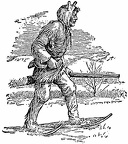 To eke out our store of corn and keep the pot boiling, my father hunted much of the time
To eke out our store of corn and keep the pot boiling, my father hunted much of the time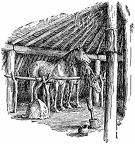 My father stabled his horses at night in our lodge, in a little corral fenced off against the wall
My father stabled his horses at night in our lodge, in a little corral fenced off against the wall Turtle, I think, was the last woman in the tribe to use an old-fashioned, bone-bladed hoe
Turtle, I think, was the last woman in the tribe to use an old-fashioned, bone-bladed hoe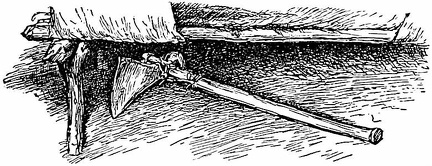 Turtle’s hoe was made of the shoulder bone of a buffalo set in a light-wood handle, the blade firmly bound in place with thong
Turtle’s hoe was made of the shoulder bone of a buffalo set in a light-wood handle, the blade firmly bound in place with thong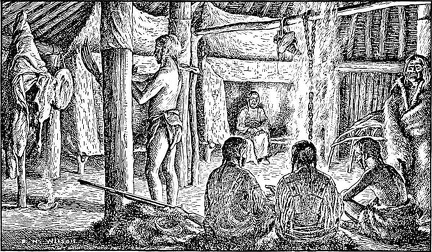 Inside the lodge
Inside the lodge Old Turtle made me a dolly of deer skin stuffed with antelope hair
Old Turtle made me a dolly of deer skin stuffed with antelope hair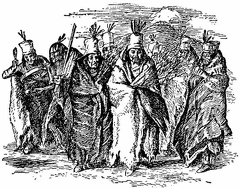 Winter clothing
Winter clothing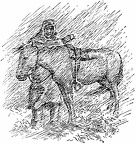 A heavy wind blew the snow in our faces, nearly blinding us
A heavy wind blew the snow in our faces, nearly blinding us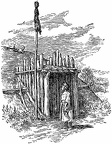 I saw that the black-bear skin was bound to one of the posts at the entrance
I saw that the black-bear skin was bound to one of the posts at the entrance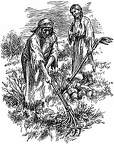 Gardening
Gardening The wild geese had come north, but this fact alone was not proof that winter had gone
The wild geese had come north, but this fact alone was not proof that winter had gone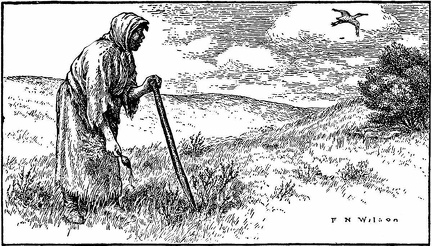 Harvesting
Harvesting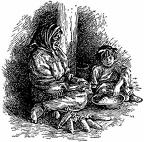 Baby-like, I ran my fingers through the shiny grain, spilling a few kernels on the floor
Baby-like, I ran my fingers through the shiny grain, spilling a few kernels on the floor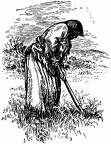 Turtle and her old-fashioned digging stick
Turtle and her old-fashioned digging stick Two braves
Two braves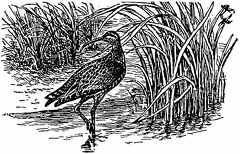 It had a long curved beak
It had a long curved beak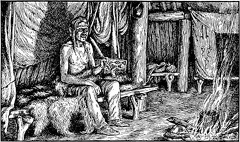 Life in an Earth Lodge
Life in an Earth Lodge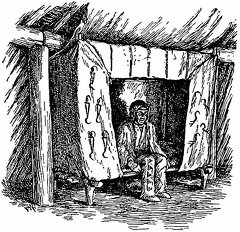 The beds of the rest of the family stood in the back of the lodge, against the wall
The beds of the rest of the family stood in the back of the lodge, against the wall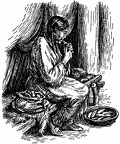 Red Blossom sat on the edge of her bed and finished her toilet
Red Blossom sat on the edge of her bed and finished her toilet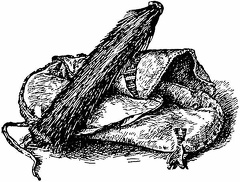 She had a little fawn-skin bag, worked with red porcupine quills
She had a little fawn-skin bag, worked with red porcupine quills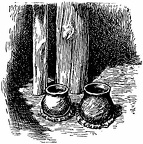 An earthen pot full of water stood by one of the posts near the fire
An earthen pot full of water stood by one of the posts near the fire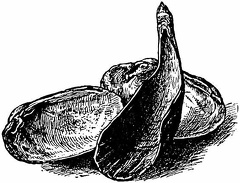 My mothers dipped each a big horn spoon full of water
My mothers dipped each a big horn spoon full of water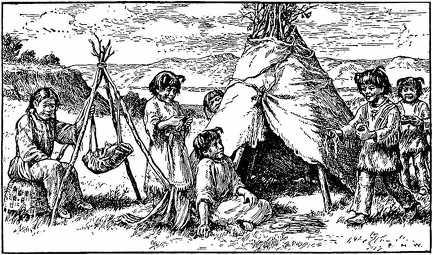 Childhood games
Childhood games They looked very terrible, all painted with the lower half of the face black
They looked very terrible, all painted with the lower half of the face black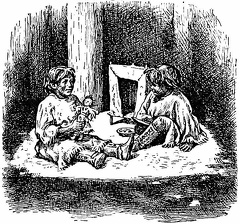 My little half sister was my usual playmate. She was two years younger than I, and I loved her dearly
My little half sister was my usual playmate. She was two years younger than I, and I loved her dearly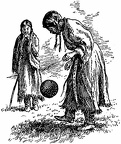 We also had a big, soft ball, stuffed with antelope hair, which we would bounce in the air with the foot
We also had a big, soft ball, stuffed with antelope hair, which we would bounce in the air with the foot The game was to see how many times she could be tossed without falling
The game was to see how many times she could be tossed without falling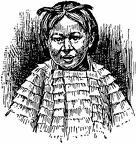 Until I was about nine years old, my hair was cut short
Until I was about nine years old, my hair was cut short Offering food before the shrine of the Big Birds’ ceremony
Offering food before the shrine of the Big Birds’ ceremony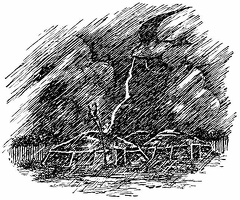 As the man sat in his lodge, there came a clap of thunder and lightning struck his roof, tearing a great hole
As the man sat in his lodge, there came a clap of thunder and lightning struck his roof, tearing a great hole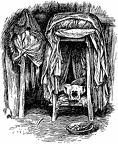 Big Birds’ ceremony
Big Birds’ ceremony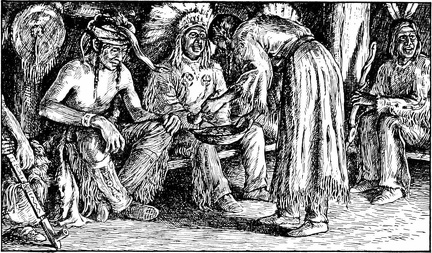 Kinship
Kinship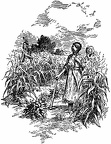 Sing louder cousin, sing louder, that I may hear you
Sing louder cousin, sing louder, that I may hear you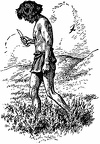 When a man mourned he cut off his hair, painted his body with white clay
When a man mourned he cut off his hair, painted his body with white clay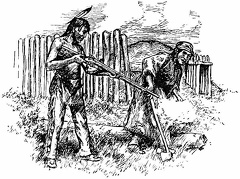 Snake Head-Ornament came close to her and fired off his gun
Snake Head-Ornament came close to her and fired off his gun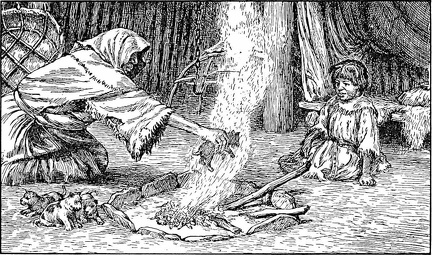 Indian Dogs
Indian Dogs In daytime lookouts were always on the roofs of some of the lodges
In daytime lookouts were always on the roofs of some of the lodges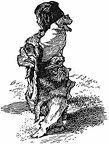 I would lay the puppy between my shoulders and draw my tiny robe up over his back
I would lay the puppy between my shoulders and draw my tiny robe up over his back She laid the grass thickly over the sides of the little tepee
She laid the grass thickly over the sides of the little tepee



